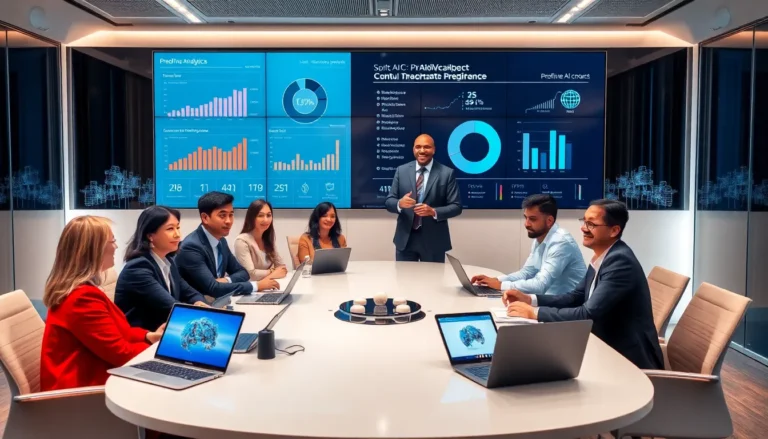Table of Contents
ToggleIn the ever-evolving tech landscape, SaaS (Software as a Service) is like that cool kid with all the trendy gadgets that everyone wants to emulate. You’re not just buying software: you’re embracing a lifestyle that promises seamless updates and no messy installations. But, the true magic lies in the ‘SaaS experience’, that sumptuous blend of functionality and user delight. So, what exactly is this SaaS experience? Buckle up because we’re diving into the world of cloud computing where user satisfaction and software efficiency reign supreme.
Understanding SaaS: A Brief Overview

SaaS, or Software as a Service, represents a paradigm shift in how software is delivered and consumed. Instead of being tied down to physical installations or purchasing licenses for individual devices, users can access applications over the internet. Think of it as ordering pizza online. You choose your toppings, place your order, and voila. Your delicious meal arrives at your door without any kitchen mess. With SaaS, companies provide users with software hosted in the cloud, allowing for easier access and flexibility.
This model has gained popularity because it reduces the burden of maintenance, updates, and system management. Users can concentrate on what truly matters, their work. And businesses can scale quickly, reflecting a crucial shift toward efficiency and adaptability.
Key Features of SaaS Experience
The SaaS experience is defined by several key features that enhance usability and satisfaction. Here’s a comprehensive breakdown:
1. Accessibility
With SaaS solutions, users can access their software from anywhere. All they need is a stable internet connection and a device. No more being tethered to a specific desktop.
2. Automatic Updates
Gone are the days of worrying about version compatibility or missing out on the latest features. SaaS applications automatically update, ensuring that users are utilizing the most up-to-date tools.
3. Subscription-Based Pricing
Forget hefty upfront costs. Most SaaS solutions work on a subscription basis, allowing for flexible payments. Businesses can choose plans that fit their needs.
4. Collaboration Tools
Many SaaS applications include built-in collaborative features, enabling teams to work together in real-time, no matter where they are located.
5. Scalability
As a business grows, its needs change. SaaS makes it easy to scale up services or user counts without a significant overhaul of existing systems.
The Importance of User Experience in SaaS
User experience holds a foundational place in the SaaS realm. Think about it: if a SaaS application is hard to use or frustrating, users will quickly turn to competitors. The importance of user experience (UX) in SaaS can be boiled down to three primary factors:
1. Retention
A product that delights users keeps them coming back. Excellent user experience minimizes churn rates, which is vital for subscription-based models.
2. Brand Loyalty
Companies with user-centered designs foster loyalty. If users feel heard and valued, they become advocates for the brand, spreading the word and bringing in new customers.
3. Competitive Advantage
In a crowded marketplace, the SaaS experience can be the differentiator that sets one service apart from the rest. Exceptional UX attracts attention and can lead to lasting relationships with clients.
Building a Positive SaaS Experience
Creating a delightful SaaS experience doesn’t just happen. It requires intentional actions that center on the user. Here are several strategies that SaaS providers can adopt:
1. User-Centric Design
Adopting a user-first mentality during the design process can significantly enhance satisfaction. Conducting usability testing and gathering feedback promotes an inclusive approach to development.
2. Customer Support
Accessible and responsive support channels are crucial. A quick response to user inquiries can turn a frustrating experience into a positive one. Providers should ensure that users can easily reach out for assistance.
3. Onboarding Processes
Providing clear and concise onboarding experiences can help new users familiarize themselves with the software. A user-friendly onboarding process minimizes confusion and enhances the overall perception of the platform.
4. Feedback Loops
Gathering continuous feedback from users is essential. Regular check-ins, surveys, or forums can help providers understand user needs and make necessary adjustments.
Challenges in Delivering a Great SaaS Experience
While creating a positive SaaS experience is vital, it comes with its share of challenges. Providers must navigate:
1. Security Concerns
Users often worry about data security and privacy. SaaS companies must prioritize robust security measures to protect sensitive information, earning user trust.
2. Integration Issues
Many organizations rely on several tools. Ensuring compatibility and seamless integration with existing software can be a significant hurdle.
3. Performance Reliability
Users expect applications to perform consistently without glitches. Downtime or slow speeds can lead to dissatisfaction and lost customers.
4. Fast-Paced Market Changes
The tech landscape evolves rapidly, compelling SaaS providers to continuously adapt and innovate. Staying ahead of trends and user expectations is essential for ongoing success.
Future Trends in SaaS Experience
Looking to the future, several trends are poised to shape the SaaS experience:
1. AI and Machine Learning
Integrating AI tools allows platforms to offer personalized experiences and smart functionalities, making for a more intuitive user interface.
2. Enhanced Analytics
Users expect more data insights. SaaS providers will integrate robust analytics to help users understand their usage patterns, behavior, and areas needing improvement.
3. Mobile Optimization
As remote work continues, the demand for mobile-first SaaS applications will rise. Responsive designs ensure users can access services on the go without sacrificing functionality.
4. Sustainability
Users are becoming increasingly aware of their carbon footprints. SaaS providers are expected to adopt sustainable practices, aligning with the values of an eco-conscious clientele.





